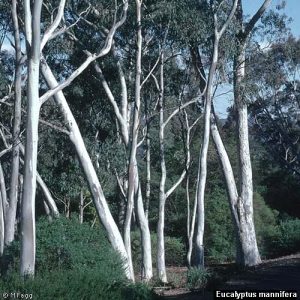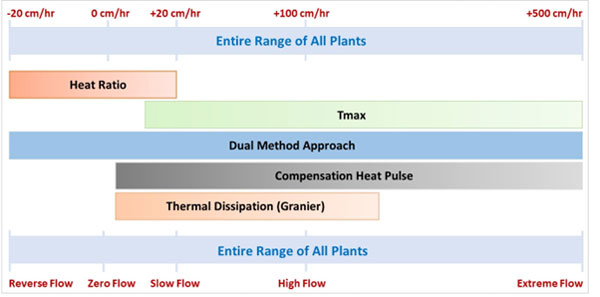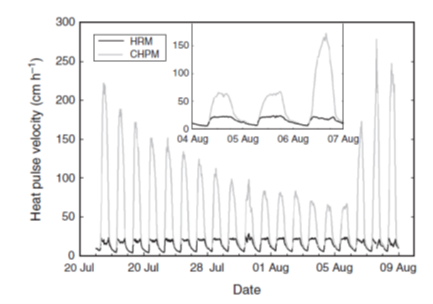Sap Flow Measurement Range.
A sap flow sensor's primary role is to measure sap flow, or water flow, in plants. It is expected that commercially available sap flow sensors should cover the entire range of sap flow within plants. However, most of these sensors surprisingly fail to perform this basic function, posing a significant obstacle to accurate scientific research across various fields, including plant physiology, hydrology, and environmental management. Understanding the inherent flaws in commercial sap flow sensors is crucial to addressing this research problem.
Understanding the Parameters.

Heat velocity in Eucalyptus mannifera was recorded at over 500 cm/hr. Image source: https://www.anbg.gov.au/gnp/gnp7/eucalyptus-mannifera.html
Plant physiologists and hydrologists present data in terms of sap flow, sap flux density, sap velocity, or heat velocity. These parameters are closely related but have distinct differences. Sap flow represents the total flow of sap across the plant's xylem tissue, while sap flux density and sap velocity both denote the amount of sap flow per unit area of xylem. Heat velocity, the rate of heat movement within the xylem, serves as the foundational parameter measured by most commercial sap flow sensors.
In summary, sap flow sensors directly measure heat velocity, which is then used to estimate sap flux density or sap velocity, and finally, total sap flow. When discussing the observable measurement range of sap flow in plants, heat velocity is the common unit of measurement.
Observable Range of Heat Velocity.
Published values of heat velocity range from approximately -20 to +500 centimetres per hour (-20 to +500 cm/hr). This range, obtained from diverse plant species, reflects the general heat velocity in most plants, with some notable outliers.
The fastest heat velocity has been recorded in species such as Eucalyptus mannifera (~500 cm/hr, Forster, 2020), grapevine (Vitis vinifera, ~110 cm/hr, Intrigliolo et al., 2009), plane tree (Platanus × acerifoli, ~150 cm/hr, Morton et al., 2016), and soybean (Glycine max, ~265 cm/hr, Cohen et al 1993).
Negative Velocity.
Some observant readers may wonder how velocity can have a negative value. Velocity, or flow, in plants can either be positive or negative. By convention, a negative value is assigned to heat velocity (or sap flux density or sap flow) when sap is moving in the direction from the canopy towards the roots. This is also known as reverse flow or hydraulic redistribution. Conversely, positive flow is sap moving in the direction from the roots, trunk, branches, and to the leaves.
Sap Flow Methods and Limitations.

A diagram summarising the measurement range of popular sap flow methods.
Various methods estimate sap flow from heat-based sensors, such as thermal dissipation, compensation heat pulse, T-max, heat ratio, and Dual Method Approach. The following diagram summarises the measurement range each
method can resolve. As the diagram shows, the Dual Method Approach stands out as the only method capable of resolving the entire heat velocity range observable in plants. Moreover, the full range of the Dual Method Approach is between -1000 to +1000 cm/hr.
A diagram summarising the measurement range of popular sap flow methods. Only the Dual Method Approach can resolve, or measure, the entire range of sap flow observable in plants. Note that the diagram is not to scale and is for illustrative purposes only.
Example: Grapevines.
The inability of most sap flow methods to measure the entire range of heat velocity was demonstrated by Pearsall et al (2014). The researchers measured sap flow in grapevines in California, USA, via the heat ratio and compensation heat pulse methods. Figure 2 in Pearsall et al (2014) demonstrates the stark contrast in measurement range between the sap flow methods. The maximum value the heat ratio measured was approximately 20 cm/hr, whereas the maximum value recorded by the compensation heat pulse method was greater than 250 cm/hr. A scientific study only relying on the heat ratio method may potentially underestimate true sap flow by orders of magnitude. Such a level of error is clearly unacceptable and must carefully be considered by sap flow scientists.

An example dataset highlighting the measurement range limitation of sap flow methods.
An example dataset highlighting the measurement range limitation of sap flow methods. In this instance, the heat ratio method underestimates true velocity with a significant amount of error. This, and many other studies, demonstrate that the heat ratio is a poor sap flow method because it cannot measure a wide range of sap flow in plants. Image source: Figure 2, Pearsall et al, 2014.
Solution: Dual Method Approach.
The Dual Method Approach, theoretically measuring heat velocity from -1000 to +1000 cm/hr, emerges as the ideal solution to the measurement range limitation. This approach has been successfully implemented in various studies, offering precise measurements across a wide range of heat velocities.
Forster (2019, 2020) provided a detailed description of the Dual Method Approach and has been subsequently implemented by Forster and Englefield (2021), Forster et al (2022), Kinzinger et al (2023), Kühnhammer et al (2023), Wheeler et al (2023), and more.
Importantly, The Dual Method Approach precisely measures zero to very slow as well as extremely fast sap flow. The Dual Method Approach is ideally suited to measuring zero, slow, moderate, and extremely fast rates of heat velocity.
Conclusion.
The observable heat velocity range in plants spans from approximately -20 to +500 cm/hr. To ensure the most accurate and reliable scientific research, it is strongly recommended that researchers consider the Dual Method Approach for sap flow projects.
References.
